How Can Body Cameras Catch Criminals
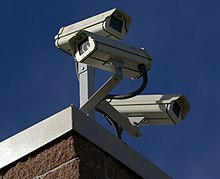
Surveillance cameras on the corner of a building.
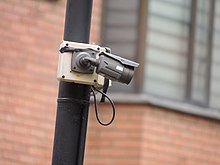
Surveillance photographic camera in a residential community.

Closed-circuit television (CCTV), also known as video surveillance,[1] [2] is the use of video cameras to transmit a signal to a specific identify, on a limited ready of monitors. It differs from broadcast television in that the point is not openly transmitted, though it may employ point-to-point (P2P), point-to-multipoint (P2MP), or mesh wired or wireless links. Even though almost all video cameras fit this definition, the term is most ofttimes applied to those used for surveillance in areas that require additional security or ongoing monitoring. (Videotelephony is seldom called "CCTV" [3] [four])
Surveillance of the public using CCTV is common in many areas around the world. In recent years, the use of body worn video cameras has been introduced as a new form of surveillance, often used in law enforcement, with cameras located on a police officer's chest or head.[5] Video surveillance has generated meaning contend most balancing its apply with individuals' correct to privacy even when in public.[6] [7] [8]
In industrial plants, CCTV equipment may be used to discover parts of a process from a central command room. For example, when the environment is non suitable for humans. CCTV systems may operate continuously or but equally required to monitor a detail event. A more advanced course of CCTV, using digital video recorders (DVRs), provides recording for perchance many years, with a variety of quality and performance options and extra features (such every bit motion detection and email alerts). More recently, decentralized IP cameras, perchance equipped with megapixel sensors, support recording straight to network-attached storage devices, or internal flash for completely stand-lone functioning.
Past one judge, there will be approximately one billion surveillance cameras in utilize worldwide by 2021.[9] [ needs update ] About 65% of these cameras are installed in Asia. The growth of CCTV has been slowing in contempo years.[10] The deployment of this technology has facilitated significant growth in state surveillance, a substantial rise in the methods of advanced social monitoring and control, and a host of crime prevention measures throughout the world.[11]
History [edit]
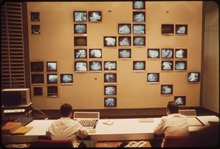
Closed excursion TV monitoring at the Cardinal Police Command Station, Munich Germany in 1973.

Desk-bound in one of the regional control-rooms of the National Police force in the Netherlands in 2017.

CCTV control-room monitor wall for 176 open up-street cameras in 2017.
An early on mechanical CCTV system was developed in June 1927 by Russian physicist Léon Theremin[12] (cf. Goggle box in the Soviet Wedlock). Originally requested past the Soviet of Labor and Defense, the system consisted of a manually-operated scanning-transmitting camera and wireless shortwave transmitter and receiver, with a resolution of a hundred lines. Having been commandeered by Kliment Voroshilov, Theremin'southward CCTV system was demonstrated to Joseph Stalin, Semyon Budyonny, and Sergo Ordzhonikidze, and subsequently installed in the courtyard of the Moscow Kremlin to monitor approaching visitors.[12]
Another early on CCTV arrangement was installed by Siemens AG at Test Stand up VII in Peenemünde, Nazi Germany in 1942, for observing the launch of V-2 rockets.[thirteen]
In the U.S. the first commercial airtight-excursion tv set system became bachelor in 1949, called Vericon. Very picayune is known nearly Vericon except it was advertised every bit not requiring a government permit.[14]
Technology [edit]
The earliest video surveillance systems involved constant monitoring considering at that place was no mode to record and store information. The development of reel-to-reel media enabled the recording of surveillance footage. These systems required magnetic tapes to be changed manually, which was a time-consuming, expensive and unreliable procedure, with the operator having to manually thread the tape from the tape reel through the recorder onto an accept-upward reel. Due to these shortcomings, video surveillance was not widespread. VCR technology became bachelor in the 1970s, making it easier to record and erase information, and the utilize of video surveillance became more common.[xv]
During the 1990s, digital multiplexing was developed, assuasive several cameras to record at in one case, every bit well every bit fourth dimension lapse and motility-merely recording. This saved fourth dimension and money which then led to an increment in the use of CCTV.[xvi]
Recently CCTV technology has been enhanced with a shift toward Internet-based products and systems, and other technological developments.[17]
Application [edit]
Airtight-excursion television was used as a form of pay-per-view theatre tv for sports such every bit professional boxing and professional wrestling, and from 1964 through 1970, the Indianapolis 500 machine race. Boxing telecasts were broadcast alive to a select number of venues, mostly theaters, where viewers paid for tickets to lookout the fight live.[18] [nineteen] The beginning fight with a closed-circuit telecast was Joe Louis vs. Joe Walcott in 1948.[xx] Closed-excursion telecasts peaked in popularity with Muhammad Ali in the 1960s and 1970s,[18] [19] with "The Rumble in the Jungle" fight drawing 50meg CCTV viewers worldwide in 1974,[21] and the "Thrilla in Manila" cartoon 100million CCTV viewers worldwide in 1975.[22] In 1985, the WrestleMania I professional wrestling show was seen by over one million viewers with this scheme.[23] As tardily as 1996, the Julio César Chávez vs. Oscar De La Hoya battle fight had 750,000 viewers.[24] Although closed-circuit television was gradually replaced by pay-per-view home cablevision television in the 1980s and 1990s, it is still in apply today for most awards shows and other events that are transmitted live to about venues but do not air as such on network television, and later re-edited for broadcast.[xix]
Marie Van Brittan Dark-brown first pioneered and patented a CCTV home security system, much of the applied science of which is still used in home security systems today ( U.S. Patent 3,482,037 ).
In September 1968, Olean, New York was the first metropolis in the Usa to install video cameras along its master business street in an effort to fight crime.[25] Some other early advent was in 1973 in Times Square in New York City.[26] The NYPD installed it to deter crime in the area; still, crime rates did not appear to drop much due to the cameras.[26] Nevertheless, during the 1980s video surveillance began to spread beyond the country specifically targeting public areas.[16] It was seen as a cheaper style to deter crime compared to increasing the size of the police departments.[26] Some businesses as well, especially those that were prone to theft, began to use video surveillance.[26] From the mid-1990s on, police departments across the country installed an increasing number of cameras in various public spaces including housing projects, schools and public parks departments.[26] CCTV later became mutual in banks and stores to discourage theft, by recording bear witness of criminal activeness. In 1997, 3,100 CCTV systems were installed in public housing and residential areas in New York City.[27]
Experiments in the Britain during the 1970s and 1980s, including outdoor CCTV in Bournemouth in 1985, led to several larger trial programs later that decade. The starting time apply past local government was in King's Lynn, Norfolk, in 1987.[28]
Uses [edit]
Crime prevention [edit]
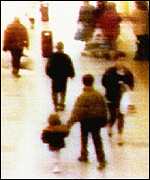
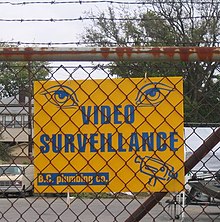
Sign warning that premises are watched past CCTV cameras.
A 2009 systematic review past researchers from Northeastern Academy and University of Cambridge used meta-analytic techniques to pool the average effect of CCTV on crime across 41 different studies.[29]
The studies included in the meta-assay used quasi-experimental evaluation designs that involve before-and-later on measures of criminal offence in experimental and command areas.[29] Notwithstanding, several researchers have pointed to methodological issues associated with this enquiry literature. First, researchers have argued that the British auto park studies included in the meta-analysis cannot accurately control for the fact that CCTV was introduced simultaneously with a range of other security-related measures.[30] Second, some have noted that, in many of the studies, there may be issues with option bias since the introduction of CCTV was potentially endogenous to previous crime trends.[31] In particular, the estimated effects may be biased if CCTV is introduced in response to criminal offence trends.[32]
It has been argued that problems of selection bias and endogeneity can be addressed by stronger research designs such as randomized controlled trials and natural experiments. A 2017 review published in Journal of Scandinavian Studies in Criminology and Crime Prevention compiles seven studies that use such enquiry designs. The studies included in the review plant that CCTV reduced crime by 24-28% in public streets and urban subway stations. Information technology too plant that CCTV could decrease unruly behaviour in football stadiums and theft in supermarkets/mass merchant stores. Notwithstanding, there was no evidence of CCTV having desirable effects in parking facilities or suburban subway stations. Furthermore, the review indicates that CCTV is more effective in preventing belongings crimes than in violent crimes.[33]
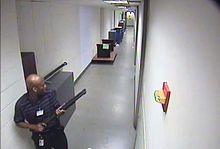
Another question in the effectiveness of CCTV for policing is effectually uptime of the system; in 2013 Urban center of Philadelphia Auditor found that the $15M system was operational just 32% of the time.[34] There is strong anecdotal evidence that CCTV aids in detection and conviction of offenders; for example, Great britain police forces routinely seek CCTV recordings after crimes.[35] Moreover, CCTV has played a crucial role in tracing the movements of suspects or victims and is widely regarded by anti-terrorist officers as a fundamental tool in tracking terrorist suspects. Large-scale CCTV installations have played a fundamental office of the defenses confronting terrorism since the 1970s. Cameras take as well been installed on public send in the hope of deterring crime.[36] [37]
A more open up question is whether virtually CCTV is price-constructive. While low-quality domestic kits are cheap, the professional installation and maintenance of high definition CCTV is expensive.[38] Gill and Spriggs did a Toll-effectiveness assay (CEA) of CCTV in crime prevention that showed little monetary saving with the installation of CCTV as most of the crimes prevented resulted in little monetary loss.[39] Critics notwithstanding noted that benefits of not-budgetary value cannot exist captured in a traditional Price Effectiveness Analysis and were omitted from their study.[39] A 2008 Written report by United kingdom of great britain and northern ireland Police force Chiefs ended that only 3% of crimes were solved by CCTV.[40] In London, a Metropolitan Police report showed that in 2008 merely i offense was solved per yard cameras.[41] In some cases CCTV cameras accept go a target of attacks themselves.[42]
Cities such as Manchester in the United kingdom of great britain and northern ireland are using DVR-based applied science to ameliorate accessibility for offense prevention.[43]
In Oct 2009, an "Cyberspace Eyes" website was announced which would pay members of the public to view CCTV photographic camera images from their homes and study any crimes they witnessed. The site aimed to add "more eyes" to cameras which might be insufficiently monitored. Ceremonious liberties campaigners criticized the idea as "a distasteful and a worrying development".[44]
In 2013 Oaxaca hired deafened law officers to lip read conversations to uncover criminal conspiracies.[45]
In Singapore, since 2012, thousands of CCTV cameras have helped deter loan sharks, nab litterbugs and end illegal parking, according to government figures.[46]
Criminal offense solving [edit]
CCTV can also exist used to help solve crimes. In London alone, six crimes are solved each mean solar day through CCTV footage.[47]
Body worn [edit]
In recent years, the use of trunk worn video cameras has been introduced for a number of uses. For example, as a new course of surveillance in law enforcement, with cameras located on a police officeholder'southward chest or caput.[48] [five]
Traffic menses monitoring [edit]
Vehicle traffic [edit]
Many cities and motorway networks have all-encompassing traffic-monitoring systems, using closed-circuit tv set to detect congestion and observe accidents.[49] [ unreliable source? ] Many of these cameras however, are owned by private companies and transmit data to drivers' GPS systems.
Highways England has a publicly endemic CCTV network of over 3000 Pan-Tilt-Zoom cameras covering the British pike and body road network. These cameras are primarily used to monitor traffic conditions and are non used as speed cameras. With the addition of stock-still cameras for the active traffic management system, the number of cameras on the Highways England's CCTV network is likely to increase significantly over the next few years.[50]
The London congestion accuse is enforced by cameras positioned at the boundaries of and inside the congestion accuse zone, which automatically read the number plates of vehicles that enter the zone. If the driver does non pay the accuse and so a fine will be imposed.[51] Similar systems are being developed every bit a means of locating cars reported stolen.[52]
Other surveillance cameras serve as traffic enforcement cameras.[53]
Pedestrian traffic [edit]
In Mecca, CCTV cameras are used for monitoring (and thus managing) the flow of crowds.[54]
In the Philippines, barangay San Antonio used CCTV cameras and bogus intelligence software to detect the germination of crowds during an outbreak of a disease. Security personnel were sent whenever a crowd formed at a detail location in the city.[55] [56] [57] [58]
Direction of infection [edit]
Increasing safety and security in public transport [edit]

Digital Video Recorder for Public Transport
On a driver-only operated train CCTV cameras may permit the driver to ostend that people are articulate of doors before closing them and starting the railroad train.[59]
A trial past RET in 2011 with facial recognition cameras mounted on trams made sure that people who were banned from them did not sneak on anyhow.[60]
Sporting events [edit]
Many sporting events in the United States use CCTV inside the venue, either to brandish on the stadium or arena'south scoreboard, or in the concourse or restroom areas to allow fans to view action outside the seating bowl. The cameras send the feed to a key command eye where a producer selects feeds to transport to the television monitors that fans can view. CCTV monitors for viewing the outcome by attendees are oft placed in lounges, hallways, and restrooms. In a trial with CCTV cameras, football club fans no longer needed to identify themselves manually, but could pass freely subsequently beingness authorized by the facial recognition system.[61]
Employee monitoring [edit]
Organizations use CCTV to monitor the deportment of workers. Every activeness is recorded as an information block with subtitles that explain the performed performance. This helps to runway the actions of workers, especially when they are making critical fiscal transactions, such as correcting or cancelling of a sale, withdrawing coin or altering personal information.
Actions which an employer may wish to monitor could include:
- Scanning of goods, choice of appurtenances, introduction of toll and quantity;
- Input and output of operators in the system when inbound passwords;
- Deleting operations and modifying existing documents;
- Implementation of certain operations, such every bit financial statements or operations with cash;
- Moving goods, revaluation scrapping and counting;
- Control in the kitchen of fast nutrient restaurants;
- Change of settings, reports and other official functions.
Each of these operations is transmitted with a clarification, assuasive detailed monitoring of all deportment of the operator. Some systems allow the user to search for a specific event past time of occurrence and text description, and perform statistical evaluation of operator behaviour. This allows the software to predict deviations from the standard workflow and record just anomalous behaviour.[62]
Employ in schools [edit]
In the The states, Britain, Canada,[63] Australia[64] and New Zealand, CCTV is widely used in schools due to its success in preventing bullying, vandalism, monitoring visitors and maintaining a record of evidence of a criminal offence. There are some restrictions, cameras non being installed in areas where there is a "reasonable expectation of privacy", such as bathrooms, gym locker areas and private offices (unless consent past the role occupant is given). Cameras are generally adequate in hallways, parking lots, front end offices where students, employees, and parents come up and go, gymnasiums, cafeterias, supply rooms and classrooms. Some teachers object to the installation of cameras.[65]
A study of high school students in Israeli schools shows that students' views on CCTV used in school are based on how they retrieve of their teachers, school, and regime.[66] Information technology too stated that nigh students do non want CCTV installed inside a classroom.[66]
Utilise in individual homes [edit]
Many homeowners choose to install CCTV systems either inside or outside their ain homes, sometimes both. CCTV cameras are an effective deterrent to potential intruders as their apply increases the risk of identification through the camera footage.[67] If someone scouts through an affluent suburb seeking the easiest firm to intermission into, having an obvious CCTV organisation, alert or another security measure out, makes the firm appear to exist a more hard target then they will probable move on to the next house.
Modern CCTV systems can be monitored through mobile phone apps which allows people to view live footage of their house from anywhere they have internet coverage. Some systems provide motion detection so when move is detected, an alert can be sent to a telephone.[68]
Criminal use [edit]
Criminals may use surveillance cameras to monitor the public. For case, a hidden photographic camera at an ATM can capture people's PINs every bit they are entered, without their knowledge. The devices are small enough not to be noticed, and are placed where they can monitor the keypad of the car every bit people enter their PINs. Images may be transmitted wirelessly to the criminal. Even lawful surveillance cameras sometimes have their data get into the hands of people who take no legal correct to receive it.[69]
Apply in shopping malls & retail stores [edit]
Theft is a huge concern for many section stores and shopping malls. CCTV helps to protect stores' assets, and ensures the safety of employees and customers. This instills a secure, prophylactic, and inviting experience for visitors.[70]
It is fifty-fifty more of import to cull the right camera. A CCTV organisation must take:
- A high resolution camera to ensure paradigm clarity
- High-capacity digital storage to ensure 24/7 recording
- The right placement with expert lighting
Prevalence [edit]
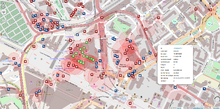
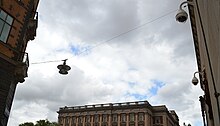
Surveillance camera mounted on the walls of Rosenbad, ane of the Swedish'south government buildings in central Stockholm, which houses the Prime Minister's office. 1 of the parliament's (Riksdagen) edifice can be seen in the groundwork.
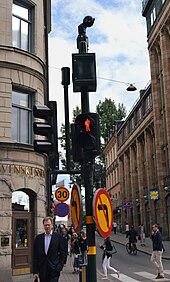
A surveillance camera, aimed at a public street (Kungsgatan) in Stockholm, Sweden, mounted on top of the pole.

Asia [edit]
Near 65% of CCTV cameras in the world are installed in Asia.[ten] In Asia, dissimilar human activities attracted the utilize of surveillance camera systems and services, including just not limited to business organisation and related industries,[ commendation needed ] [72] transportation,[73] sports,[74] and care for the environment.[75]
In 2018, China was reported to have a huge surveillance network of over 170 1000000 CCTV cameras with 400 million new cameras expected exist installed in the next three years, many of which use facial recognition technology.[76]
United States [edit]

At that place were an estimated 30 one thousand thousand surveillance cameras in the U.s.a. in 2011.[77] Video surveillance has been common in the The states since the 1990s; for instance, one manufacturer reported internet earnings of $120 million in 1995.[78] With lower cost and easier installation, sales of home security cameras increased in the early 21st century. Following the September 11 attacks, the utilize of video surveillance in public places became more common to deter future terrorist attacks.[26] Under the Homeland Security Grant Program, government grants are bachelor for cities to install surveillance photographic camera networks.[79] [fourscore] [81] In 2009, there were an estimated fifteen,000 CCTV systems in Chicago, many linked to an integrated camera network.[82] [83] [84] New York Metropolis'due south Domain Awareness System has 6,000 video surveillance cameras linked together,[85] there are over four,000 cameras on the subway system (although most half of them practise not work),[86] and 2-thirds of large flat and commercial buildings use video surveillance cameras.[87] [88] In Washington, D.C. in that location are more than 30,000 surveillance cameras in schools,[89] and the Metro has nearly six,000 cameras in use across the arrangement.[xc]
United kingdom of great britain and northern ireland [edit]
In the United Kingdom, the vast majority of CCTV cameras are operated non by authorities bodies, but by private individuals or companies, especially to monitor the interiors of shops and businesses. Co-ordinate to the Liberty of Information Human action 2000 requests, the total number of local government operated CCTV cameras was around 52,000 over the entirety of the UK.[91]
An commodity published in CCTV Image magazine estimated the number of private and local regime operated cameras in the United Kingdom was ane.85 meg in 2011. The estimate was based on extrapolating from a comprehensive survey of public and private cameras within the Cheshire Constabulary jurisdiction. This works out as an boilerplate of 1 camera for every 32 people in the United kingdom of great britain and northern ireland, although the density of cameras varies greatly from place to place. The Cheshire report also claims that the average person on a typical day would be seen by lxx CCTV cameras.[92]
The Cheshire effigy is regarded every bit more undecayed than a previous study by Michael McCahill and Clive Norris of UrbanEye published in 2002.[92] [93] Based on a pocket-size sample in Putney High Street, McCahill and Norris extrapolated the number of surveillance cameras in Greater London to be around 500,000 and the total number of cameras in the UK to be around 4,200,000. Co-ordinate to their estimate the United kingdom has one camera for every 14 people. Although information technology has been acknowledged for several years that the methodology backside this figure is flawed,[94] it has been widely quoted. Furthermore, the effigy of 500,000 for Greater London is frequently confused with the figure for the police and local government operated cameras in the City of London, which was about 650 in 2011.[91]
The CCTV User Group estimated that there were effectually i.5 million private and local government CCTV cameras in city centres, stations, airports, and major retail areas in the UK.[95]
Research conducted past the Scottish Centre for Crime and Justice Research and based on a survey of all Scottish local authorities, identified that there are over 2,200 public space CCTV cameras in Scotland.[96]
Canada [edit]
Project SCRAM is a policing effort by the Halton Regional Police Service to register and aid consumers understand the complex issues of privacy and safety that confront households when dealing with installations of domicile security systems. "The SCRAM programme enables community members to voluntarily place and register their residential video surveillance equipment through a uncomplicated, secure, confidential, online form."[97] Information technology has not been extended to commercial businesses. A broad-ranging effort to provide registration and monitoring of home security and systems. "Security photographic camera registration and monitoring is a customs-based crime prevention opportunity and investigative tool that enlists the help of residents and can assist preclude crime on three levels. Residential video surveillance cameras tin can deter criminals from entering the area, tin can prevent crimes from occurring and help solve crimes by providing valuable show to the law."[97]
South Africa [edit]
In South Africa due to the high criminal offense rate CCTV surveillance is widely prevalent but the land has been tedious to implement the latest engineering science due east.m. the showtime IP camera was released in 1996 by Axis Communications but IP cameras didn't arrive in South Africa till 2008.[98] To regulate the number of suppliers in 2001 the Individual Security Manufacture Regulation Deed was passed requiring all security companies to be registered with the Private Security Manufacture Regulatory Authority (PSIRA).[99]
Latin America [edit]
In Latin America, the CCTV market is growing rapidly with the increase of property offense.[100] Installation of CCTV camera is increasing day by 24-hour interval and the criminal offense is somewhat controlled.[101]
Russia [edit]

Soviet motorized CCTV camera
The number of CCTV cameras equipped with facial biometrics in Moscow'southward public surveillance network is prepare to grow by lxx times from the current 1,500 to 105,000 by the terminate of the year. The CCTV system in Moscow can at present recognize faces using an algorithm based on neural networks. City camera recordings are analyzed in real-time. Faces on the screen are scanned and tin can be checked against several databases, such every bit the police database, to identify a suspect. This belittling arrangement tin can also help police force recreate a suspect'southward movements effectually the city. The organization searches for related recordings from diverse CCTV cameras and identifies the aforementioned face from several sightings. The Moscow network includes 160,000 CCTV cameras and 95 percent of residential buildings. By the end of the year, residents will exist able to install CCTV cameras on private buildings themselves while connecting them to the unified video observation organization. This year, over iii,500 cameras have been connected to the Full general Center for Data Storage and Processing. This includes cameras in archway halls, schools and kindergartens, at MCC stations, stadiums, public transport stops and jitney terminals, and in parks. Video recordings are used to solve 70 percentage of offenses and crimes. The cameras likewise aid monitor utility services. A department spokesperson added that Moscow has one of the largest security systems in the world with such a comprehensive identification arrangement[102]
Video surveillance and terrorism [edit]
Textile collected by surveillance cameras has been used as a tool in post-event forensics to identify tactics, techniques and perpetrators of terrorist attacks. Furthermore, there are diverse projects − such as INDECT − that aim to detect suspicious behaviours of individuals and crowds.[103] It has been argued that terrorists won't be deterred by cameras, that terror attacks aren't actually the field of study of the current apply of video surveillance and that terrorists might even see it as an extra channel for propaganda and publication of their acts.[104] [105] In Federal republic of germany calls for extended video surveillance past the land's primary political parties, SPD, CDU and CSU have been dismissed equally "piddling more than a placebo for a subjective feeling of security" by a member of the Left political party.[106]
Privacy [edit]

A mobile closed-circuit Television van monitoring a street market
Proponents of CCTV cameras argue that cameras are effective at deterring and solving crime, and that appropriate regulation and legal restrictions on surveillance of public spaces can provide sufficient protections so that an individual's right to privacy can reasonably exist weighed confronting the benefits of surveillance.[107] Nonetheless, anti-surveillance activists take held that there is a right to privacy in public areas. Furthermore, while information technology is truthful that there may be scenarios wherein a person'due south right to public privacy can be both reasonably and justifiably compromised, some scholars have argued that such situations are so rare as to not sufficiently warrant the frequent compromising of public privacy rights that occurs in regions with widespread CCTV surveillance. For example, in her book Setting the Picket: Privacy and the Ethics of CCTV Surveillance, Beatrice von Silva-Tarouca Larsen argues that CCTV surveillance is ethically permissible only in "certain restrictively defined situations", such as when a specific location has a "comprehensively documented and significant criminal threat".[108]
In the United states, the Constitution does non explicitly include the right to privacy although the Supreme Court has said several of the amendments to the Constitution implicitly grant this correct.[109] Access to video surveillance recordings may require a gauge's writ, which is readily bachelor.[110] However, in that location is little legislation and regulation specific to video surveillance.[111] [112]
All countries in the European union are signatories to the European Convention on Human Rights which protects individual rights including the right to privacy. The EU's Data Protection Directive regulates access to personal information including CCTV recordings.[113] This directive is translated into the national law of each country within the Eu.
In the United kingdom the Data Protection Act 1998 imposes legal restrictions on the uses of CCTV recordings and mandates the registration of CCTV systems with the Data Protection Bureau. In 2004, the successor to the Data Protection Agency, the Information Commissioner's Part clarified that this required registration of all CCTV systems with the Commissioner, and prompt deletion of archived recordings. However, subsequent instance police force (Durant vs. FSA) limited the scope of the protection provided past this law, and not all CCTV systems are currently regulated.[114]
A 2007 study by the UK Data Commissioner'southward Office, highlighted the need for the public to be made more enlightened of the growing use of surveillance and the potential impact on ceremonious liberties.[115] [116] In the aforementioned year, a entrada grouping claimed the majority of CCTV cameras in the Britain are operated illegally or are in breach of privacy guidelines.[117] In response, the Information Commissioner's Office rebutted the claim and added that any reported abuses of the Information Protection Human action are swiftly investigated.[117] Even if at that place are some concerns arising from the employ of CCTV such as involving privacy,[118] more commercial establishments are nonetheless installing CCTV systems in the UK.
In 2012, the Uk government enacted the Protection of Freedoms Act which includes several provisions related to decision-making and restricting the collection, storage, retentivity, and employ of information about individuals. Nether this Act, the Home Office published a code of practise in 2013 for the use of surveillance cameras by government and local government. The aim of the code is to help ensure their use is "characterised as surveillance past consent, and such consent on the role of the community must be informed consent and not causeless past a system operator. Surveillance by consent should be regarded as analogous to policing by consent."[119]
In Canada, the use of video surveillance has grown very rapidly. In Ontario, both the municipal and provincial versions of the Liberty of Information and Protection of Privacy Act outline very specific guidelines that command how images and information tin can be gathered by this method and or released.[120]
In Sweden, the use of CCTV in public spaces is regulated both nationally and via GDPR (the European privacy act). The national legislation requires permits for public operators (except for law-enforcement agencies since one January 2020) to install CCTV in spaces that allow access to the full general public. In an stance poll deputed past Lund University in August 2017, the general public of Sweden were asked to choose one measure that would ensure their need for privacy when field of study to CCTV-functioning in public spaces: 43% favored regulation in the grade of clear routines for managing, storing and distributing image cloth generated from surveillance cameras, 39% favored regulation in the form of clear signage informing that camera surveillance in public spaces is present, 2% favored regulation in the class of having permits restricting the use of surveillance cameras during certain times of 24-hour interval/week, 10% favored regulation in the form of having restrictive policies for issuing permits for surveillance cameras in public spaces, and 6% were unsure or did not know.[121]
Technological developments [edit]

Surveillance camera at London Heathrow Aerodrome with a wiper for articulate images during rain
Computer-controlled analytics and identification [edit]
Computer-controlled cameras can identify, rail, and categorize objects in their field of view.[122]
Video content analysis, also referred to as video analytics, is the capability of automatically analyzing video to detect and determine temporal events not based on a single image, only rather object nomenclature.[123] In the concluding decade, improved VCA features have been developed. Beyond recognizing specific shapes and colors, VCA applications now can analyze more than complex scenarios.
Advanced VCA applications tin can accurately classify object types based on their shape and motion behavior and they tin as well measure object speed. Some video analytics applications can be used to nearly utilize rules to designated areas. These rules can relate to admission control. For example, they tin can describe which objects tin can enter into a specific surface area, when they are immune to enter or within what circumstances. Virtually applied rules can as well relate to various motion situations. VCA based CCTV systems can be set to detect anomalies in a oversupply, for example a person moving in the reverse management in which they are normally expected (e.g. debarking from a plane at an drome or exiting through an archway in a subway).[124]
There are dissimilar approaches to implementing VCA technology. Information may be processed on the camera itself (edge processing) or by a centralized server. Both approaches accept their pros and cons.[125]

Eye-in-the-heaven surveillance dome camera watching from a high steel pole
To many, the evolution of CCTV in public areas, linked to computer databases of people's pictures and identity, presents a serious breach of ceremonious liberties. Critics fear such engineering volition lead to the loss of anonymity in public places.[126]
Retention, storage and preservation [edit]
There is a toll in the retentivity of the images produced by CCTV systems. The amount and quality of information stored on storage media is subject to pinch ratios, images stored per second, image size and is effected by the retention flow of the videos or images.[127] DVRs shop images in a variety of proprietary file formats. Recordings may be retained for a preset corporeality of time then automatically archived, overwritten or deleted, the menses beingness determined by the system that generated them.
IP cameras [edit]

A growing branch in CCTV is internet protocol cameras (IP cameras). Information technology is estimated that 2014 was the first year that IP cameras outsold analog cameras.[128] IP cameras use the Internet Protocol (IP) used past about Local Area Networks (LANs) to transmit video beyond information networks in digital form. IP can optionally be transmitted across the public internet, assuasive users to view their cameras remotely on a reckoner or phone via an net connexion. For professional or public infrastructure security applications, IP video is restricted to within a private network or VPN.[129] IP cameras are considered part of the Internet of Things (IoT) and have many of the same benefits and security risks equally other IP-enabled devices.[130]
Master types of IP cameras include: stock-still cameras, pan-tilt-zoom (PTZ) cameras and multi-sensor cameras.[131] Fixed cameras' resolution tin vary based on the application area, just typically does not exceed 20 MP. The main feature of a PTZ is its remote directional and optical zoom adequacy. With multi-sensor cameras, wider areas can be monitored and hundreds of megapixel resolution can be achieved.
Industrial video surveillance systems use network video recorders to back up IP cameras. These devices are responsible for the recording, storage, video stream processing and alarm direction.
Since 2008, IP video surveillance manufacturers tin can use a standardized network interface (ONVIF) to support compatibility between systems.[132]
Networking CCTV cameras [edit]
The city of Chicago operates a networked video surveillance system which combines CCTV video feeds of regime agencies with those of the private sector, installed in city buses, businesses, public schools, subway stations, housing projects etc.[133] Even homeowners are able to contribute footage. It is estimated to incorporate the video feeds of a full of 15,000 cameras.[134]
The system is used by Chicago's Function of Emergency Management in case of an emergency call: it detects the caller's location and instantly displays the real-fourth dimension video feed of the nearest security photographic camera to the operator, not requiring whatever user intervention. While the system is far besides vast to allow complete real-time monitoring, it stores the video information for use as evidence in criminal cases.[135]
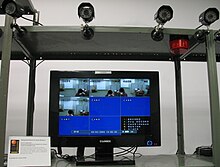
An integrated systems unit.
Wireless security cameras [edit]

Many consumers are turning to wireless security cameras for domicile surveillance. Wireless cameras exercise not crave a video cable for video/audio transmission, but a cable for power. Wireless cameras are also easy and inexpensive to install merely lack the reliability of hard-wired cameras.[136] Previous generations of wireless security cameras relied on analogue engineering science; modern wireless cameras apply digital engineering which delivers crisper audio, sharper video, and a secure and interference-free indicate.[137]
Talking CCTV [edit]
In Wiltshire, UK, 2003, a pilot scheme for what is now known every bit "Talking CCTV" was put into action; allowing operators of CCTV cameras to order offenders to stop what they were doing, ranging from ordering subjects to selection up their rubbish and put information technology in a bin to ordering groups of vandals to disperse. In 2005, Ray Mallon, the mayor and former senior police force officer of Middlesbrough implemented "Talking CCTV" in his surface area.[138]
Other towns have had such cameras installed. In 2007 several of the devices were installed in Bridlington town heart, East Riding of Yorkshire.[139]
Countermeasures [edit]
Due to the widespread implementation of surveillance cameras, glasses are existence congenital which can defeat CCTV cameras. In December 2016 a form of anti-CCTV and facial recognition sunglasses called 'reflectacles' were invented past a custom-spectacle-craftsman based in Chicago named Scott Urban.[140] They reflect infrared and, optionally, visible lite which makes the users face a white blur to cameras. The project easily surpassed its funding goal of $28,000 and reflectacles became commercially available in June 2017.[141]

See likewise [edit]
- Artificial intelligence for video surveillance
- Bugging
- "CATV" equally cable television—not to be dislocated with CCTV
- Closed-circuit tv camera
- Digital video recorder
- Documentary exercise
- Centre in the sky (photographic camera)
- Fake security photographic camera
- INDECT
- Information Awareness Part
- IP camera
- Motion (surveillance software)
- Optic Nerve (GCHQ)
- Physical security
- Physical security data direction (PSIM)
- Privacy International
- Security operations center
- Security smoke
- Shodan (website)
- Smart photographic camera
- Smart city
- Sousveillance (inverse surveillance)
- Super recognisers
- Surveillance
- Telescreen
- The Convention on Modernistic Freedom
- TV Network Protocol
- Under vehicle inspection
- Video analytics
- Video bear witness
- Videotelephony
- Washington County Airtight-Circuit Educational Television Project
- Webcam
- Temperature Monitoring Thermal Camera
- Smart Home
- Surveillance Drone
- IoT
Notes [edit]
References [edit]
- ^ Kumar, Vikas; Svensson, Jakob, eds. (2015). Promoting Social Change and Democracy Through Information technology. IGI Global. p. 75. ISBN9781466685031.
- ^ Dempsey, John Due south. (2008). Introduction to private security. Belmont, CA: Thomson Wadsworth. p. 78. ISBN9780534558734.
- ^ Verman, Romesh. Distance Education In Technological Historic period, Anmol Publications Pvt. Ltd., 2005, pp.166, ISBN 81-261-2210-2, ISBN 978-81-261-2210-three.
- ^ "Distance instruction in Asia and the Pacific: Proceedings Of The Regional Seminar On Altitude Education, 26 November - three December 1986", Asian Development Bank, Bangkok, Thailand, Volume ii, 1987
- ^ a b Hung, Vivian; Babin, Steven; Coberly, Jacqueline. "A Market Survey on Trunk Worn Camera Technologies" (PDF). The Department of Justice's National Institute of Justice. Johns Hopkins University Applied Physics Laboratory.
- ^ "What'due south wrong with public video surveillance?". ACLU. Retrieved 5 January 2017.
- ^ "Surveillance Cameras and the Right to Privacy". CBS News. 13 August 2010. Retrieved 5 January 2017.
- ^ "All-time PoE Security Camera Arrangement". CBS News. 9 November 2019. Retrieved v Jan 2017.
- ^ Nash, Jim (10 Jan 2020). "Global sales of video surveillance equipment projected to surpass $20 billion this twelvemonth". Biometric Update . Retrieved 26 October 2020.
- ^ a b "Rise of Surveillance Camera Installed Base of operations Slows". 5 May 2016. Retrieved five January 2017.
- ^ Caves, R. W. (2004). Encyclopedia of the Metropolis. Routledge. p. 114.
- ^ a b Glinsky, Albert. (2000). Theremin : ether music and espionage. Urbana: University of Illinois Press. pp. 46–47. ISBN0252025822. OCLC 43286443.
- ^ Dornberger, Walter: V-ii, Ballantine Books 1954, ASIN: B000P6L1ES, folio 14.
- ^ "Television set Rides Wires" , February 1949, Popular Scientific discipline small article, bottom of page 179
- ^ Kruegle, Herman (15 March 2011). CCTV Surveillance. ISBN9780080468181.
- ^ a b Roberts, Lucy. "History of Video Surveillance and CCTV Archived 21 December 2019 at the Wayback Machine" We C U Surveillance Retrieved 2011-10-20
- ^ "Cyberspace based CCTV on cloud services" (in Finnish). fennoturvapalvelut. 27 March 2015.
- ^ a b Ezra, Michael (2013). The Economic Ceremonious Rights Motility: African Americans and the Struggle for Economic Power. Routledge. p. 105. ISBN9781136274756.
- ^ a b c "History of Prizefighting's Biggest Money Fights". Bloody Elbow. SB Nation. 24 August 2017.
- ^ Television. Frederick A. Kugel Company. 1965. p. 78.
Teleprompter's main-leap, Irving B. Kahn (he's chairman of the board and president), had a taste of closed excursion operations as early every bit 1948. That summer, Kahn, and then a vice president of 20th Century-Fox, negotiated what was probably the get-go inter-city closed circuit telecast in history, a pickup of the Joe Louis-Joe Walcott fight.
- ^ "Zaire's fight promotion opens new golden mines". The Morning Herald. eighteen Nov 1974.
- ^ "Karriem Allah". Black Belt. Agile Interest Media, Inc.: 35 1976.
- ^ "Wrestlemania In Photographs: i-10". Sportskeeda. 1 April 2017.
- ^ Chavez-De La Hoya Fight Is A Bout About Contrasts, Chicago Tribune article, 1996-06-07, Retrieved on 2015-02-23
- ^ [Robb, Gary C. (1979) "Police force Employ of CCTV Surveillance: Ramble Implications and Proposed Regulations" University of Michigan Journal of Police force Reform. pg. 572]
- ^ a b c d e f [Yesil, Bilge. (2006) "Watching Ourselves" Cultural Studies. Vol twenty(four-5) pp. 400-416]
- ^ Who's Watching? Video Camera Surveillance in New York Urban center and the Demand for Public Oversight (PDF). 2006. p. v. Retrieved 30 January 2022.
- ^ Staff (Baronial 2007). "CCTV". Borough Council of Male monarch's Lynn & Due west Norfolk. Archived from the original on 23 May 2009. Retrieved xiv December 2008.
- ^ a b "Public Area CCTV and Law-breaking Prevention: An Updated Systematic Review and Meta-Analysis". Journalist's Resource.org. xi February 2014.
- ^ Zehnder (2009). "The economics of subjective security and photographic camera surveillance" (PDF). Archived from the original (PDF) on six July 2017. Retrieved 27 October 2017.
- ^ Priks, Mikael (1 November 2015). "The Effects of Surveillance Cameras on Crime: Evidence from the Stockholm Subway". The Economic Journal. 125 (588): F289–F305. doi:10.1111/ecoj.12327. ISSN 1468-0297. S2CID 96452277.
- ^ Stutzer (2013). "Is camera surveillance an effective measure out of counterterrorism?". Defense and Peace Economics. 24: ane–14. doi:10.1080/10242694.2011.650481.
- ^ Gustav Alexandrie (2017). "Surveillance cameras and crime: a review of randomized and natural experiments". Journal of Scandinavian Studies in Criminology and Crime Prevention. 18 (ii): 210–222. doi:10.1080/14043858.2017.1387410. S2CID 149144413.
- ^ "Orphaned Video Organisation in Philadelphia?". May 2015. Archived from the original on 28 Oct 2017. Retrieved 29 July 2015.
- ^ "Police are declining to recover crucial CCTV footage, new figures propose", The Daily Telegraph
- ^ "CCTV to bulldoze downwardly cab attacks", BBC
- ^ "Taxi CCTV cameras are installed", BBC
- ^ "National community Criminal offense Prevention Program" (PDF). Archived from the original (PDF) on 29 February 2016. Retrieved 30 March 2016.
- ^ a b "Assessing the impact of CCTV" (PDF). Archived from [http:/rds.homeoffice.gov.u.k./rds/pdfs05/rdsolr1205.pdf the original] (PDF) on 18 February 2011. Retrieved 16 Oct 2011.
- ^ "Are CCTV cameras a waste of money in the fight against law-breaking?" Archived 4 March 2016 at the Wayback Auto Forrad Edge, 7 May 2008
- ^ Hughe, Mark (25 August 2009). "CCTV in the spotlight: one criminal offense solved for every 1,000 cameras". Contained News and Media Limited.
- ^ "http://news.bbc.co.uk/" BBC
- ^ "Digital CCTV Scheme Switches On," BBC
- ^ Public to Monitor CCTV From Dwelling house, BBC
- ^ Angels of Silence see crime where others don't Globe & Mail, 20 November 2013
- ^ "Network of CCTV cameras proving effective". straitstimes. 8 March 2016. Retrieved 6 Feb 2017.
- ^ "'Six crimes a day' solved by CCTV, Met says". 26 December 2010 – via www.bbc.com.
- ^ Bayley, David H.; Stenning, Philip C. (2016). Governing the Police: Feel in 6 Democracies. Transaction Publishers. ISBN978-1412862318.
- ^ Motorway Cameras in England, http://www.motorwaycameras.co.united kingdom of great britain and northern ireland
- ^ Networx Security. "Closed Circuit Tv." Retrieved vii March 2019.
- ^ Kablenet, The Annals. "TfL hands out contracts for congestion charge tags." 6 June 2008. Retrieved 7 March 2019.
- ^ Rowena Coetsee, Bay Surface area News Group. "New surveillance cameras doing their job, Antioch's top cop says." 11 August 2017. Retrieved eight March 2019.
- ^ Prof. Eugene Volokh, The Wall Street Periodical. "Traffic Enforcement Cameras." 26 March 2002. Retrieved 8 March 2019.
- ^ "Saudi arabia installs new security cameras in Makkah". Al Arabiya English. 26 May 2016.
- ^ "Pasig hamlet well on its way to becoming 'smart barangay'". SovereignPH. 12 March 2020.
- ^ "AI-equipped CCTV cameras enable a barangay to monitor people out on the streets". world wide web.topgear.com.ph.
- ^ "Pasig Mayor Vico Sotto turns to smart CCTV to enforce social distancing".
- ^ News, G. M. A. "Pasig barangay turns to smart CCTV to enforce social distancing". GMA News Online.
- ^ FCC Train Dispatch training video, 25 March 2013, archived from the original on 30 June 2014, retrieved 26 July 2018 (From 7:35 the video explains near DOO train dispatch anddescribes the use of CCTV at stations.)
- ^ "Facial recognition cameras to be installed on Rotterdam trams". 11 September 2011.
- ^ "Doe mee aan de proef met gezichtsherkenning". Heracles. 26 March 2019.
- ^ "Using CCTV to monitor the workplace". icaew. Retrieved 18 September 2016.
- ^ ATL (22 October 2013). "Apply of CCTV surveillance in schools". ATL the education union. Retrieved 8 November 2016.
- ^ Bruce McDougall and Katherine Danks (28 March 2012). "School security CCTV puts bullies on suspension". The Daily Telegraph . Retrieved eight November 2016.
- ^ "Legal aspects of the use of video cameras in schools =". Archived from the original on fifteen February 2016. Retrieved 25 March 2014.
- ^ a b Birnhack, Michael D.; Perry-Hazan, Lotem (2020). "Schoolhouse Surveillance in Context: High School Students' Perspectives on CCTV, Privacy, and Security". SSRN Electronic Journal. doi:10.2139/ssrn.3587450. ISSN 1556-5068. S2CID 234991261.
- ^ Surette, Ray. "The thinking eye: Pros and cons of second generation CCTV surveillance systems". Policing: An International Journal of Police Strategies & Management.
- ^ Wollerton, Megan. "Plow an quondam telephone into a security photographic camera in 3 steps. Here's how to exercise it". cnet.com. Cnet. Retrieved 18 June 2021.
- ^ "Benalla. Trois policiers suspendus pour avoir transmis des images de vidéosurveillance". twenty July 2018.
- ^ "Retail surveillance systems". videosurveillance.com . Retrieved 18 July 2021.
- ^ khris78. "The CCTV Map". osmcamera. Archived from the original on 25 October 2014. Retrieved two August 2014.
- ^ Walton, Greg (2001). China's Golden Shield: corporations and the development of surveillance technology in the Red china. Rights & Democracy.
- ^ "Australian state authorities to aggrandize CCTV use across transport network". Archived from the original on 2 April 2015. Retrieved 11 March 2015.
- ^ "Chinese Television station CCTV provide 'sometime schoolhouse' analysis of AFC Asian Loving cup match". Retrieved 11 March 2015.
- ^ "Indian state government uses CCTV to cutting forest crimes". Archived from the original on eleven October 2014. Retrieved eleven March 2015.
- ^ "Smart cameras catch homo in 60,000 oversupply". BBC News. thirteen April 2018. Retrieved 13 April 2018.
- ^ Technocreep : the give up of privacy and the capitalization of intimacy. [S.50.]: Greystone Books. 2014. p. 28. ISBN978-1771641227 ; "Surveillance Social club: New High-Tech Cameras Are Watching You". Popular Mechanics. 30 September 2009. Retrieved 31 Oct 2015 ; "Lawmakers want more surveillance on the ground -- and in the sky". NBC News. 20 April 2013. Retrieved 31 October 2015 ; Dempsey, John; Forst, Linda (2015). An Introduction to Policing. Cengage Learning. p. 485. ISBN9781305544680.
- ^ "Public Video Surveillance: Is Information technology An Effective Offense Prevention Tool?". California Enquiry Bureau. June 1997. Retrieved 5 February 2015.
The popularity of CCTV security systems has not gone unnoticed by the manufacturers of camera surveillance systems. ...A leading CCTV manufacturer reported net earnings of $120 meg in 1995, compared with cyberspace earnings of $16 1000000 the previous year. ...Over 50 per centum of all CCTV surveillance equipment sales are to industrial and commercial clients. CCTV surveillance is as well very common in the American workplace.
- ^ Minoli, Daniel (2013). Building the internet of things with IPv6 and MIPv6 the evolving world of M2M communications. New Jersey: Wiley. p. 86. ISBN9781118647134.
- ^ "The bang-up surveillance blast". Fortune. 26 Apr 2013. Retrieved 24 January 2016.
- ^ "Privacy Fears Abound equally Cities Increase Surveillance". The New York Times. 13 Oct 2013. Retrieved 5 January 2017.
- ^ "Chicago'southward Camera Network Is Everywhere". Wall Street Journal. 17 November 2009. Retrieved 5 January 2017.
- ^ "Chicago Links Police force, Private Cameras". WLS-Telly. 2010. Archived from the original on six April 2010. Retrieved 16 Baronial 2010.
- ^ "Chicago'due south Video SURVEILLANCE CAMERAS: A PERVASIVE AND UNREGULATED THREAT TO OUR PRIVACY" (PDF). ACLU of Illinois. February 2011. Archived from the original (PDF) on 27 March 2016. Retrieved 5 January 2017.
- ^ "NYPD expands surveillance internet to fight offense likewise as terrorism". Reuters. 21 June 2013. Retrieved 31 October 2015.
- ^ "Lack of Video Slows Hunt for a Killer in the Subway". The New York Times. 29 March 2010. Retrieved 31 October 2015.
- ^ "The State Of Surveillance". Bloomberg Business organisation. vii August 2005. Retrieved 31 October 2015.
- ^ "The Building Has 1,000 Eyes". The New York Times. iv October 2013. Retrieved five January 2017.
- ^ "thirty,000 Surveillance Cameras Monitor D.C.-Area Public Schools". NBC Washington. 1 January 2015. Archived from the original on 6 October 2015. Retrieved 31 October 2015.
- ^ "Metro Plans to Triple Number of Security Cameras". NBC Washington. i Apr 2013. Retrieved 31 Oct 2015.
- ^ a b "The Price of Privacy: How local authorities spent £515m on CCTV in 4 years" (PDF). Large Brother Watch. February 2012. p. xxx. Archived from the original (PDF) on 23 September 2015. Retrieved four February 2015.
- ^ a b "You're beingness watched: at that place's one CCTV photographic camera for every 32 people in Britain - Inquiry shows 1.85m machines across Britain, virtually of them indoors and privately operated". The Guardian. 2 March 2011. Retrieved 7 Jan 2017.
- ^ "CCTV in London" (PDF) . Retrieved 22 July 2009.
- ^ "FactCheck: how many CCTV cameras?". Channel 4 News. 18 June 2008. Retrieved 8 May 2009.
- ^ "How many cameras are there?". CCTV User Grouping. eighteen June 2008. Archived from the original on 23 Oct 2008. Retrieved 8 May 2009.
- ^ Bannister, J., Mackenzie, South. and Norris, P. Public Space CCTV in Scotland(2009), Scottish Center for Crime and Justice Research (Research Report)
- ^ a b I Vision, One Mission, One Squad Archived fourteen January 2016 at the Wayback Car(2014), Halton Regional Police Service
- ^ "CCTV Systems". Retrieved 24 February 2017.
- ^ "PSIRA ACT" (PDF). Private Security Industry Regulatory Authority. 25 February 2002. Retrieved 12 October 2016.
- ^ "Latin American Physical Security Market Growing Rapidly," viii October 2009 Security Magazine
- ^ Sandip. "CCTV Photographic camera Installation Guide". NP Tech Solution . Retrieved 28 Dec 2019.
- ^ McGoogan, Cara (29 September 2017). "Facial recognition fitted to v,000 CCTV cameras in Moscow". Archived from the original on 11 Jan 2022 – via www.telegraph.co.uk.
- ^ Mould, Nick; Regens, James Fifty.; Jensen, Carl J.; Edger, David N. (30 August 2014). "Video surveillance and counterterrorism: the application of suspicious activity recognition in visual surveillance systems to counterterrorism". Journal of Policing, Intelligence and Counter Terrorism. nine (2): 151–175. doi:x.1080/18335330.2014.940819. S2CID 62710484.
- ^ "In the Petabyte Historic period of Surveillance, Software Polices". Popular Mechanics. 10 May 2010. Retrieved 4 Jan 2017.
- ^ "Mehr Videoüberwachung gegen Terroristen - WDR aktuell - Sendung - Video - Mediathek - WDR". WDR. 26 October 2016. Retrieved 4 January 2017.
- ^ "Calls increase for sweeping surveillance later on Berlin attack". Deutsche Welle. Retrieved iv January 2017.
- ^ Kroener, Inga (2014). CCTV: A Technology Under the Radar?. Ashgate Publishing. ISBN9781472400963.
- ^ Beatrice Von Silva-Tarouca Larsen (2011). Setting the lookout: Privacy and the ethics of CCTV surveillance. Hart Publishing. p. 160. ISBN9781849460842.
- ^ "Your Right to Privacy". American Ceremonious Liberties Union.
- ^ Department of Justice - Video Surveillance Retrieved 6 August 1982
- ^ "What'southward Incorrect With Public Video Surveillance". American Ceremonious Liberties Marriage. Retrieved 24 January 2016.
- ^ Inga Kroener (2014). CCTV: A Technology Under the Radar?. Ashgate Publishing. p. 110. ISBN9781472400963.
- ^ Kroener, Inga (2014). CCTV: A Technology Under the Radar?. Ashgate Publishing. p. 107. ISBN9781472400963.
- ^ "Memorandum by A A Adams, BSc, MSc, PhD, LLM, MBCS, CITP School of Systems Applied science". UK Parliament Constitution Committee - Written Prove. Surveillance: Citizens and the State. January 2007.
- ^ "Privacy watchdog wants curbs on surveillance". The Telegraph. i May 2007. Archived from the original on 11 January 2022.
- ^ "CCTV, computers and the 'climate of fear'". Evening Standard. thirty April 2007.
- ^ a b "Majority of Great britain's CCTV cameras 'are illegal'". The Telegraph. 31 May 2007. Archived from the original on two June 2007. Retrieved eighteen July 2021.
- ^ "Dwelling surveillance CCTV images may alienation data protection laws, ECJ rules". TheGuardian.com. 11 Dec 2014. Retrieved 11 March 2015.
- ^ "Surveillance Photographic camera Code of Do" (PDF). Uk Government Dwelling Part. June 2013. p. 5. Retrieved 1 Dec 2013.
- ^ Liberty of Information and Protection of Privacy Act Archived 24 September 2007 at the Wayback Machine Text
- ^ Lahtinen, Markus (2017). "The perception of surveillance cameras and privacy among the general public in Sweden" (PDF). LUSAX-research group, Lund University School of Economics and Direction, Sweden.
- ^ James Vincent, The Verge. "Artificial Intelligence Is Going To Supercharge Surveillance." 23 January 2018. Retrieved 25 March 2019
- ^ 2018 9th International Conference on Information and Communication Systems (ICICS) : 3-five April 2018, Jordan Academy of Scientific discipline and Engineering science, Irbid, Jordan. Jordan University of Scientific discipline & Technology, Found of Electric and Electronics Engineers. Hashemite kingdom of jordan Department,, Constitute of Electrical and Electronics Engineers. Piscataway, New Jersey. ISBN9781538643662.
{{cite volume}}: CS1 maint: others (link) - ^ "MATE'due south Analytics Integrate with Hirsch Security Systems". Archived from the original on 16 February 2009. Retrieved 28 March 2011.
- ^ "Image Processing Techniques for Video Content Extraction" (PDF).
- ^ Todd Lewan (7 July 2007). "Microchips in humans spark privacy debate". USAToday . Retrieved 7 June 2012.
- ^ "MotionJPEG, JPEG2000, H.264 and MPEG-4 compression methods in CCTV". Retrieved 1 May 2011.
- ^ "Global value of IP camera sales now close to 50% of CCTV cameras sold, but..." nineteen December 2013.
- ^ "Dispelling the Elevation 10 Myths of IP Surveillance" (PDF) . Retrieved xxx March 2016.
- ^ "Securing IP Surveillance Cameras in the IoT Ecosystem - Noticias de seguridad - Trend Micro MX". www.trendmicro.com (in Spanish). Retrieved 18 Feb 2020.
- ^ "Selecting the virtually suitable cameras to monitor large areas". internationalsecurityjournal.com. International Security Periodical. Retrieved 23 June 2021.
- ^ "ONVIF: a guide to the open security platform". ifsecglobal.com. IFSEC Global. Retrieved 23 June 2021.
- ^ "The Metropolis of Chicago's OEMC and IBM Launch Advanced Video Surveillance Organisation". IBM News Room.
- ^ William M. Bulkeley. "Chicago's Camera Network Is Everywhere". Wall Street Journal.
- ^ "Chicago's Camera Network Is Everywhere", The Wall Street Journal
- ^ "CCTV Photographic camera Installation Guide".
- ^ Sadun, Erica (26 Dec 2006). Digital Video Essentials: Shoot, Transfer, Edit, Share By Erica Sadun. ISBN9780470113196 . Retrieved 16 Oct 2013.
- ^ "Town trials talking CCTV cameras". BBC News. 17 September 2006.
- ^ "'Talking' CCTV cameras are tested". BBC News. 25 March 2007.
- ^ "Exist Seen and Unseen! Reflectacles are the Sunglasses of the Future".
- ^ "Reflectacles - Reflective Eyewear and Sunglasses". Kickstarter.
Further reading [edit]
- Armstrong, Gary, ed. (1999). The maximum surveillance lodge: the ascent of CCTV. Berg (originally, Academy of Michigan Press). ISBN9781859732212.
- Fyfe, Nicholas; Bannister, Jon (2005). "City Watching: Airtight-Circuit Television in Public Spaces". In Fyfe, Nicholas; Kenny, Judith T. (eds.). The Urban Geography Reader . Psychology Press. ISBN9780415307017.
- Nassauer, Anne (2018). "How Robberies Succeed or Neglect: Analyzing Crime Defenseless on CCTV". Periodical of Enquiry in Crime and Malversation. 55 (1): 125–154. doi:ten.1177/0022427817715754.
- Newburn, Tim; Hayman, Stephanie (2001). Policing, Surveillance and Social Control: CCTV and police monitoring of suspects. Taylor & Francis. ISBN9781843924692.
- Norris, Clive (2003). "From Personal to Digital: CCTV, the panopticon, and the technological mediation of suspicion and social control". In Lyon, David (ed.). Surveillance as Social Sorting: Privacy, Run a risk, and Digital Bigotry. Psychology Press. ISBN9780415278737.
External links [edit]
- Assessing the Touch on of CCTV, a UK Home office study on the effectiveness of closed-circuit tv
Source: https://en.wikipedia.org/wiki/Closed-circuit_television
Posted by: shriversincy1977.blogspot.com


0 Response to "How Can Body Cameras Catch Criminals"
Post a Comment